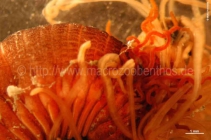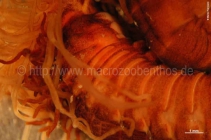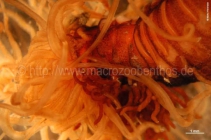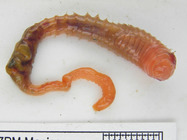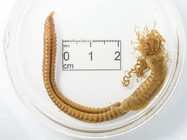
| About | | Search taxa | | Taxon tree | | Search literature | | Specimens | | Distribution | | Checklist | | Stats | | Log in |
Deep-Sea taxon detailsAmphitrite cirrata Müller, 1776
131474 (urn:lsid:marinespecies.org:taxname:131474)
accepted
Species
marine,
recent only
Müller, O.F. (1776). Zoologiae Danicae Prodromus, seu Animalium Daniae et Norvegiae Indigenarum characters, nomina, et synonyma imprimis popularium. <em>Typis Hallageriis, Havniae.</em> 32: 1-282., available online at http://www.biodiversitylibrary.org/item/47550
page(s): 216; note: Almost listing only but has three word diagnosis (cincinnis utrinque tribus) and refers back to Müller, 1771:188 [details]
Note Uncertain type locality, but possibly Iceland....
From editor or global species database
Type locality Uncertain type locality, but possibly Iceland. Amphitrite cirrata is based on earlier names, rather than being a new taxon founded by Müller in his work on Danish & Norwegian fauna. There is no location given in Müller (1776), but in Müller (1771: 188) he appears to mention Iceland for the name Spio cirrata König, and the Hartman catalogue (1959: 496) gives Iceland as the locality for Amphitrite cirrata. Jirkov (2020 : 327) states that "However, later Read, Fauchald (2020i) changed the type locality to “United Kingdom Exclusive Economic Zone”, which cannot be accepted." This was a misunderstanding by Jirkov of the WoRMS presentation. The 'type localities' displayed were NOT of Amphitrite cirrata itself, rather they were from linked synonymous name records (including a misspelling and an unnecessary new name) which should not have types. The WoRMS records are now updated to display correctly. [details]
Distribution [ Relevant to Canadian Atlantic waters only. Non-taxonomist NWARMS entry]. Gulf of St. Lawrence (unspecified region),...
Distribution [ Relevant to Canadian Atlantic waters only. Non-taxonomist NWARMS entry]. Gulf of St. Lawrence (unspecified region), southern Gaspe waters (Baie des Chaleurs, Gaspe Bay to American, Orphan and Bradelle banks; eastern boundary: eastern Bradelle Valley), downstream part of middle St. Lawrence estuary, lower St. Lawrence estuary, Prince Edward Island (from the northern tip of Miscou Island, N.B. to Cape Breton Island south of Cheticamp, including the Northumberland Strait and Georges Bay to the Canso Strait causeway); lower North Shore; Cobscook Bay to Cape Hatteras [details] Nomenclature Strictly the name should be "Amphitrite cirrosa (Linnaeus, 1767). However, prevailing usage almost ever since Müller...
Nomenclature Strictly the name should be "Amphitrite cirrosa (Linnaeus, 1767). However, prevailing usage almost ever since Müller introduced the name has accepted and preferred to use Amphitrite cirrata Müller. Code Article 23.9, reversing precedence has not been invoked by an author as far as is known, but would likely apply (retaining A. cirrata Müller). Noting that the 1788 13th edition of Systema Naturae does not mention either name for species of Amphitrite. There are no "Amphitrite cirrosa" true records (but some false ones) indexed by BHL or ION at this time [G. Read comment, March 2015] [details]
Read, G.; Fauchald, K. (Ed.) (2025). World Polychaeta Database. Amphitrite cirrata Müller, 1776. Accessed through: Glover, A.G.; Higgs, N.; Horton, T. (2025) World Register of Deep-Sea species (WoRDSS) at: https://marinespecies.org/deepsea/aphia.php?p=taxdetails&id=131474 on 2025-07-17
Glover, A.G.; Higgs, N.; Horton, T. (2025). World Register of Deep-Sea species (WoRDSS). Amphitrite cirrata Müller, 1776. Accessed at: https://www.marinespecies.org/deepsea/aphia.php?p=taxdetails&id=131474 on 2025-07-17
Date action by
original description
Müller, O.F. (1776). Zoologiae Danicae Prodromus, seu Animalium Daniae et Norvegiae Indigenarum characters, nomina, et synonyma imprimis popularium. <em>Typis Hallageriis, Havniae.</em> 32: 1-282., available online at http://www.biodiversitylibrary.org/item/47550
page(s): 216; note: Almost listing only but has three word diagnosis (cincinnis utrinque tribus) and refers back to Müller, 1771:188 [details] taxonomy source Hessle, Christian. (1917). Zur Kenntnis der terebellomorphen Polychaeten. <em>Zoologiska bidrag från Uppsala.</em> 5: 39-258, plates I-V., available online at https://biodiversitylibrary.org/page/38891407 page(s): 185 [details] taxonomy source Jirkov, Igor A. (2020). Review of the European Amphitrite (Polychaeta: Terebellidae) with description of two new species. <em>Invertebrate Zoology.</em> 17(4): 311-360., available online at https://kmkjournals.com/journals/Inv_Zool/IZ_Index_Volumes/IZ_17/IZ_17_4_311_360 page(s): 324, figures 1A, E, 2A, 9, 10.; note: description and figures and taxonomic discussion [details] context source (Deepsea) Intergovernmental Oceanographic Commission (IOC) of UNESCO. The Ocean Biogeographic Information System (OBIS), available online at http://www.iobis.org/ [details] basis of record Bellan, G. (2001). Polychaeta, <i>in</i>: Costello, M.J. <i>et al.</i> (Ed.) (2001). European register of marine species: a check-list of the marine species in Europe and a bibliography of guides to their identification. <em>Collection Patrimoines Naturels.</em> 50: 214-231. (look up in IMIS) [details] additional source Brunel, P., L. Bosse & G. Lamarche. (1998). Catalogue of the marine invertebrates of the estuary and Gulf of St. Lawrence. <em>Canadian Special Publication of Fisheries and Aquatic Sciences, 126.</em> 405 pp. (look up in IMIS) [details] Available for editors additional source Pollock, L.W. (1998). A practical guide to the marine animals of northeastern North America. Rutgers University Press. New Brunswick, New Jersey & London. 367 pp., available online at http://books.google.com/books?id=i1AmT31cuR4C [details] additional source Muller, Y. (2004). Faune et flore du littoral du Nord, du Pas-de-Calais et de la Belgique: inventaire. [Coastal fauna and flora of the Nord, Pas-de-Calais and Belgium: inventory]. <em>Commission Régionale de Biologie Région Nord Pas-de-Calais: France.</em> 307 pp., available online at http://www.vliz.be/imisdocs/publications/145561.pdf [details] additional source Hartman, Olga. (1948). The polychaetous annelids of Alaska. <em>Pacific Science.</em> 2(1): 3-58., available online at https://research.nhm.org/dataimages/alaska/Hartman_1948.pdf page(s): 43-44 [details] Available for editors additional source Hartman, Olga. (1959). Catalogue of the Polychaetous Annelids of the World. Parts 1 and 2. <em>Allan Hancock Foundation Occasional Paper.</em> 23: 1-628. [details] Available for editors additional source Integrated Taxonomic Information System (ITIS). , available online at http://www.itis.gov [details] additional source Fabricius, O. (1780). Fauna Groenlandica, systematice sistens animalia groenlandiae occidentalis hactenus indagata, quoad nomen specificium, triviale, vernaculumque, synonyma auctorum plurimum, descriptionem, locum, victum, generationem, mores, usum capturamque singuli, pro ut detegendi occasio fuit, maximaque parte secundum proprias observationes. [Fauna Greenland, systematically presenting the animals of Western Greenland so far investigated, as to the specific name, trivial, vernacular, synonyms of the authors for the most part, description, place, life, generation, manners, use and catch of each one, as there was an opportunity to discover, and for the most part according to personal observations.]. <em>Hafniae [= Copenhagen] & Lipsiae [= Leipzig], Ioannis Gottlob Rothe.</em> xvi + 452 pp., 1 pl., available online at https://www.biodiversitylibrary.org/page/13442285 page(s): 285-286 [details] additional source Dewarumez, Jean-Marie (look up in IMIS) [details] additional source Holthe, T. (1986). Evolution, systematics, and distribution of the Polychaeta Terebellomorpha, with a catalogue of the taxa and a bibliography. <em>Gunneria.</em> 55: 1-236., available online at http://www.diva-portal.org/smash/get/diva2:331918/FULLTEXT01.pdf [details] additional source Malmgren, Anders Johan. (1866? vol for 1865). Nordiska Hafs-Annulater. [part three of three]. <em>Öfversigt af Königlich Vetenskapsakademiens förhandlingar, Stockholm.</em> 22(5): 355-410, plates XVIII-XXIX., available online at https://biodiversitylibrary.org/page/32339631 page(s): 375, plate XXI fig. 53 [details] additional source McIntosh, W.C. 1923. A monograph of the British marine annelids. Polychaeta, Sabellidae to Serpulidae. With additions to the British marine Polychaeta during the publication of the monograph. Ray Society of London, 4(2): 251-538. [details] additional source Müller, Otto Friedrich. 1771. Von Würmern des süssen und salzigen Wassers. 1-200. H. Mumme and Faber. Copenhagen., available online at https://www.biodiversitylibrary.org/page/14389400 page(s): 188; note: here Müller mentions Spio cirrata, but it is not an available name [details] additional source Okuda, Shiro. (1937). Annelida Polychaeta in Onagawa Bay and its vicinity. I. Polychaeta Sedentaria. <em>Science Reports of the Tohoku Imperial University. Fourth Series Biology.</em> 12(1): 45-69, plate 2. page(s): 58; note: Further record for Japan with brief diagnosis. ION reports this record indexed under 'Amphitrite cirrosa' but Okuda uses the accepted A. cirrata spelling [details] additional source Liu, J.Y. [Ruiyu] (ed.). (2008). Checklist of marine biota of China seas. <em>China Science Press.</em> 1267 pp. (look up in IMIS) [details] Available for editors additional source Trott, T. J. (2004). Cobscook Bay inventory: a historical checklist of marine invertebrates spanning 162 years. <em>Northeastern Naturalist.</em> 11, 261-324., available online at http://www.gulfofmaine.org/kb/files/9793/TROTT-Cobscook%20List.pdf [details] Available for editors redescription Jirkov, I.A. (2001). [Polychaeta of the Arctic Ocean] (In Russian) Polikhety severnogo Ledovitogo Okeana. Yanus-K Press, Moscow, 632 pp., available online at https://www.researchgate.net/publication/259865957_Jirkov_2001_Polychaeta_of_the_North_Polar_Basin [details] Available for editors  Present Present  Inaccurate Inaccurate  Introduced: alien Introduced: alien  Containing type locality Containing type locality
From editor or global species database
Distribution [ Relevant to Canadian Atlantic waters only. Non-taxonomist NWARMS entry]. Gulf of St. Lawrence (unspecified region), southern Gaspe waters (Baie des Chaleurs, Gaspe Bay to American, Orphan and Bradelle banks; eastern boundary: eastern Bradelle Valley), downstream part of middle St. Lawrence estuary, lower St. Lawrence estuary, Prince Edward Island (from the northern tip of Miscou Island, N.B. to Cape Breton Island south of Cheticamp, including the Northumberland Strait and Georges Bay to the Canso Strait causeway); lower North Shore; Cobscook Bay to Cape Hatteras [details]Editor's comment McIntosh (1922) discussed unpublished plate figures of Montagu (reported by McIntosh as named Amphiro cirrata and Amphiro foetida) in relation to Amphitrite cirrata, with Amphiro cirrata listed in the synonymy. These names are treated as nomina dubia here and cannot be linked to A. cirrata formal synonymy. [details] Nomenclature Strictly the name should be "Amphitrite cirrosa (Linnaeus, 1767). However, prevailing usage almost ever since Müller introduced the name has accepted and preferred to use Amphitrite cirrata Müller. Code Article 23.9, reversing precedence has not been invoked by an author as far as is known, but would likely apply (retaining A. cirrata Müller). Noting that the 1788 13th edition of Systema Naturae does not mention either name for species of Amphitrite. There are no "Amphitrite cirrosa" true records (but some false ones) indexed by BHL or ION at this time [G. Read comment, March 2015] [details] Publication date In 1776 Müller uses the name and gives a three word diagnosis (cincinnis utrinque tribus). He refers back to Müller, 1771:188, where Müller refers to a preceding name of Spio cirrata König, apparently from Iceland, but strictly Müller doesn't use the combination Amphitrite cirrata and doesn't make the name available there. (His 1771 text is written in cursive German script, and is difficult to convert to a modern German character set.) [details] Synonymy Amphitrite cirrata has been in prevailing usage since late 1700s at least (see Fabricius, 1780:285, although strictly "Nereis cirrosa" of Linnaeus, 1767:1085 is the senior objective synonym. Both names were apparently derived in relation to a pre-Linnaean name, Spio cirrata König, about which no further information seems available. Linnaeus appears to have changed the epithet spelling, whereas Müller retained the spelling of König, but also mentioned Linnaeus's usage. Many subsequent authors were aware of the Linnaeus spelling, but still used the Müller spelling with Linnaeus's name as a synonym. See also the code interpretation of A. cirrata at AnimalBase, namely that it is an "Unjustified emendation of Nereis cirrosa Linné, 1767. Objective junior synonym of Nereis cirrosa Linné, 1767. Müller 1771: 188 mentioned cirrosa and cirrata under Amphitrite, but this was only for the purposes of citation, Müller 1771 did not use any of the names." [details] Type locality Uncertain type locality, but possibly Iceland. Amphitrite cirrata is based on earlier names, rather than being a new taxon founded by Müller in his work on Danish & Norwegian fauna. There is no location given in Müller (1776), but in Müller (1771: 188) he appears to mention Iceland for the name Spio cirrata König, and the Hartman catalogue (1959: 496) gives Iceland as the locality for Amphitrite cirrata. Jirkov (2020 : 327) states that "However, later Read, Fauchald (2020i) changed the type locality to “United Kingdom Exclusive Economic Zone”, which cannot be accepted." This was a misunderstanding by Jirkov of the WoRMS presentation. The 'type localities' displayed were NOT of Amphitrite cirrata itself, rather they were from linked synonymous name records (including a misspelling and an unnecessary new name) which should not have types. The WoRMS records are now updated to display correctly. [details] Unreviewed
Habitat Known from seamounts and knolls [details]Habitat infralittoral and circalittoral of the Gulf and estuary [details]
To Barcode of Life (41 barcodes)
To Biodiversity Heritage Library (110 publications) To European Nucleotide Archive, ENA (Amphitrite cirrata) To GenBank (41 nucleotides; 33 proteins) To Macrozoobenthos communities of Svalbard To NHMUK collection (Amphitrite cirrata Müller; NON-TYPE; NHMUK:ecatalogue:9474050) To PESI To The Arctic Traits Database (27 traits) To USNM Invertebrate Zoology Annelida Collection (7 records) To ITIS |


